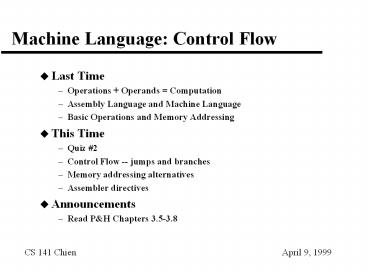Machine Language: Control Flow - PowerPoint PPT Presentation
1 / 18
Title:
Machine Language: Control Flow
Description:
Basic Operations and Memory Addressing. This Time. Quiz #2. Control Flow -- jumps and branches ... power and flexibility of computers (more than a calculator) ... – PowerPoint PPT presentation
Number of Views:42
Avg rating:3.0/5.0
Title: Machine Language: Control Flow
1
Machine Language Control Flow
- Last Time
- Operations Operands Computation
- Assembly Language and Machine Language
- Basic Operations and Memory Addressing
- This Time
- Quiz 2
- Control Flow -- jumps and branches
- Memory addressing alternatives
- Assembler directives
- Announcements
- Read PH Chapters 3.5-3.8
2
Control Flow
- Idea Dont always want the same sequence of
instructions - Conditional execution increases the power and
flexibility of computers (more than a calculator) - program runs can be much longer than program size
(more complex computations)
3
Achieving Conditional Execution
- Sequential Instruction Sequence (default)
- Next Instruction Current Instruction address
4 - 4 bytes per instruction
- Need another way to choose the next instruction
- Conditional Branch Operation
- beq reg1, reg2, LABEL
- if reg1reg2 Next LABEL else Next Current
4
LABEL (branch Taken)
(branch not Taken)
4
Example
Loop add 1, 2, 3 add 1, 1, 4 add 1, 1,
5 beq 1, 0, Loop ...
- Label -gt value for the branch target
- 0 is always 0
- Conditional test
- This code sequence computes
- Conditions Outcomes
- 2345 0 Loop forever
- otherwise Loop until 1 lt 0
5
C conditionals and Assembly Language
... ... if (a ! 0) a a1 beq 5, 0,
Else ... addi 5,5,1 Else ...
- Implementing a C conditional (if... else)
- Suppose a is in 5
- True execution path
- False execution path
- What if the condition test was more complex?
6
Conditional Branch Instructions
- bne reg1,reg2,Label Branch Not Equal
- beq reg1,reg2,Label Branch Equal
- Complementary tests
- Only tests for equality
- What if you want to compare magnitudes?
- e.g. AgtB, AltB, etc.
7
Comparing Magnitudes
- slt reg1,reg2,reg3 Set if less than
- if reg3 lt reg2, reg1 1
- else reg1 0
- beq tests value of the comparison
- Why doesnt the machine put this all together
into condition codes, and compute them for every
instruction?
8
Condition codes an Alternative Approach
... ... if (AgtB) ... slt 1,6,5 ... bne
1,0, ThenClause Else ...
- Every arithmetic instruction sets condition codes
such as Zero, NonZero, GreaterThan, Equal,
LessThan, Carry, etc. - Conditional instructions test these bits
- Condition codes computed as side effect of the
arithmetic - No additional instructions required to explicitly
compute these codes - Problem getting condition codes right on every
instruction complicates hardware design - Explicit testing doesnt cost much.
9
Another Example Non-restoring Divide
int dividend, divisor, quotient,
remainder quotient remainder 0 while
(dividend gt 0) quotient quotient 1
dividend dividend - divisor remainder
dividend divisor quotient quotient - 1
- Suppose your machine doesnt have a divide
instruction - Division by repeated subtraction (non-restoring
divide) - Inefficient, but does compute the correct answer
10
Non-restoring Divide (Assembly)
Memory Map dividend 1 divisor 2 quotient 3 re
mainder 4
move 3,0 move 4,0 Loop slt 5,1,0 bne
5,0,End addi 3,3,1 sub 1,1,2 beq
0,0,Loop End add 4,1,2 subi 3,3,1
- Basic Parts
- slt test, beq, fixup
11
Memory Addressing
- lw reg1, Offset(reg2)
- Displacement Mode
- the ONLY memory addressing mode in MIPS
- reg1 target, Offset 16 bit displacment, reg2
added to offset - Many alternative complex modes
- Multiple registers
- Multiple constants
- Variable size constants
- Most can be efficiently synthesized from this one
primitive
12
Immediate Operands
- addi 10,10,4 Constants in the Instruction
- 16 bit constants fit easily
- Thats why they use the I format, not R!
- sign extend (copy top bit to upper 16 bits)
- 2s complement, 16-gt32 bit representation, same
value - larger constants constructed by shifting, then
ORing
13
Addressing in Conditional Branches
- beq reg1,reg2,Label Conditional Branch
- How is the label represented?
- Label must capture the target instructions
address (32 bits) - But, we only have 16 bits of space.... what
should we do?
14
Branch Target Addressing
- A Use a relative branch target instruction
address - Target Program counter (16 bit constant ltlt 2)
- a 32-bit address
- Limits the distance one can branch
- Example
- Loop Inst 88
- Inst 92
- Inst 96
- beq 1,2,Loop 100
- What offset should go in the beq instruction?
15
Conditional Branches
- Execution
- Operations, Complex control flow
- Relation to C, Loops, etc.
- All the pieces, but what is missing?
- How does the assembler decide where to place
things? Where to put the program, data, etc? - Assembler Directives
16
Assembler Directives
- Labels -- already covered
- Instructions -- already covered
- .globl label external labels
- .text program to follow this
- .data data region to follow
- .word 2643 data representation size
- .half 43
- .byte 6 Beware assembler may pack these
together - Alignment directives
- .asciiz stringvalue convenient specification
- of strings
17
Typical Program
.text .globl ...labels for external
stuff... ... instructions (the
program) ... .data .word xxx .word yyy .word zzz
...
- Program Part
- Static Data Part
- Heap allocated things and stack below the static
data region
18
Summary
- Operations Operands Computation
- But, Operations Control Flow A Program
- Instructions and Assembler Directives together
produce an executable assembly program - Next Time
- Procedure Calls

